Valiada Snow was in the papers. Even when journalists didn’t have a scrap to write about her, pictures of her glowing, smiling, singing and generally being gorgeous would show up alongside unrelated articles in the entertainment section. She had sponsorships, showing up in newspaper ads for RC Cola and hair treatments. She traveled the nation and the world, acting, dancing, singing, and playing trumpet.
Snow’s fall from fame and memory has been blamed on the diversity of her talent. If she had only been a torch singer, we would’ve remembered her. If she had only been a dancer, she would’ve made history. If she had only been a trumpet player, modern audiences would know her as well as Louis Armstrong. But Valaida Snow was never only one thing or another. Even within a specialty, her talent was diverse. In one oft reported performance, Snow concluded a number on the trumpet with a dance number where, for each chorus, she danced in a different pair of shoes. “The dances and shoes to match were: soft-shoe, adagio shoes, tap shoes…, Dutch clogs, Chinese straw sandals, Turkish slippers, and the last pair, Russian boots” (Reitz, 1982). Her singing was comparably varied. In addition to torch songs and blues, she was one of the few black entertainers to sing Broadway tunes as well (Mosley, 2020).
The trumpet was Snow’s primary instrument, but she also played cello, bass, violin, guitar, banjo, mandolin, harp, accordion, clarinet, and saxophone (Charles, 1995). She conducted bands, produced shows, designed costumes, spoke seven languages (Cowans, 1943) and was reportedly a fine painter (“Valaida Snow Engagement at Orpheum,” 1946). She could write down music as it was being played (Reitz, 1982). She was also the master fabricator of her own story.
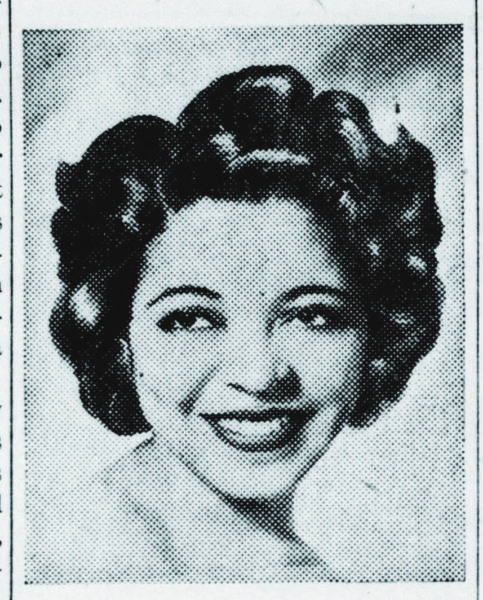
Tall Tales of Little Louis
One of the biographical ‘facts’ that is often included in articles about Valaida Snow, both on the internet and in newspaper, was of her capture by Nazis in Denmark during WWII, and detainment in a concentration camp for 18 months where she suffered malnutrition and abuse. It isn’t unusual that stories can become exaggerated and embellished as they are retold, but this story, as biographer Mark Miller and biographic novelist Candace Allen found out, is a complete fabrication perpetrated from the beginning by Snow herself.
Upon returning to the U.S., Valaida Snow gave interviews in 1942 that were printed in the Chicago Defender and the New York Amsterdam, discussing her departure from Denmark at the onset of Nazi occupation. In these interviews, she talks of being forced to stay in Denmark after her manager left, because of a contractual commitment to the clubs in which she was working. The work dried up, however, and Snow was forced to ration out her savings for the months she knocked around Denmark and Sweden on her own. Before she was granted passage home, she was detained in prison for her safety for five days, allowed to go out during the day under strict curfew. She lost some weight on a lean, potato based diet, and was forced to leave a large portion of her possessions behind when her travel was finally approved. Her outlook was rosy. She was un-defeatable, and full of praise and empathy for the Scandinavian people currently suffering through occupation.
The story she later told in the Michigan Chronicle in 1943 was vastly different. In this new version, she had been captured by invading Nazis, sent to a concentration camp with hundreds of other Americans, confined in solitary, and lashed every morning. Later embellishments, of Snow herself or concocted by others, included her throwing herself in the way of the lash to protect a small girl, being imprisoned for 18 or 20 months, and returning home weighing only 68 or seventy some pounds. While we can never know whether or not Snow suffered hardship during the occupation of Denmark by German troops, many of the assertions in her later story do not align with documented history. The first and only concentration camp in Denmark was established in 1944, nearly three years after Snow returned to the states. The concentration camp in Copenhagen where Snow claimed to be held, identified as Wester-Faenglse Prison in later reports, was not a concentration camp at all, but the main jail of Copenhagen, most often used for pre-trial detainees. While the Germans did occupy Denmark in 1940, the king and government were allowed to function as normal in a de facto protectorate until 1943 when a larger military presence arrived, partially in response to the Danish people’s reticence to report or collect Jewish citizens.
Anyone who stumbles onto Snow’s story would be excited to learn of her incomparable talent and her genius of entertainment. She traveled and performed world wide, from China and the Middle East, to Paris and London. She presented herself as an other worldly and powerful individual, reportedly matching the uniforms of her chauffeur, footman, and pet monkey to her orchid colored Mercedez‐Benz. Finding out that she survived brutal treatment in a concentration camp at the hands of the Nazis, and recovered to relaunch her career, makes her seem larger than life. And, yet the story of her internment is utterly false. I can say that the shock experienced upon learning this is immense and confusing. It threatens to throw a shadow on her accomplishments regardless of their magnitude.
However, I would argue that one of those accomplishments included how Snow built her own persona by strategic marketing and story making. Valiada Snow’s propensity to spin stories for the press was hinted at in how aggressively she marketed herself as “Little Louis.” As a trumpet player, she modeled herself on Louis Armstrong, telling a story of how impressed Armstrong was with her playing that he dubbed her “Little Louis.” It is possible that this story was also a concoction by Snow, who took advantage of the comparison to secure work and notoriety.
While accusations of imitation would’ve been insulting and damaging to many entertainers, women performers in largely male entertainment fields adopted this tactic to wedge themselves into a culture from which they would usually be barred (Provost, 2017). Most women traveling the performance circuit in the States did so in the company of a trusted man, as they found this the only way to secure jobs in a male dominated profession while also ensuring their own safety. Valaida Snow’s choice of instrumental focus was also a taboo one. At the time, it was socially unacceptable for women to play wind instruments. Instruments like the trombone, trumpet, coronet, and saxophone were considered especially masculine (Charles, 1995). Even into the 70s, the idea that jazz was a male domain prevailed, as one man was quoted: “jazz is a male language. It’s a matter of speaking that language and women just can’t do it” (Provost, 2017). Actively marketing herself as ‘Little Louis’ gave her the curiosity and foot-in-the-door she needed to propel her career.
Yet, it is unclear how much Valaida Snow actually copied Louis Armstrong’s music in her performances. Her biographer, Miller found her recordings to be nearly copies of Armstrong’s, however, scholar Sarah Caissie Provost found little similarity in Valaida Snow’s recorded catalog when compared with Armstrong:
“Out of Snow’s 60 solo recordings, Armstrong also recorded versions of nineteen of these songs. Three of these–“It Had to Be You,”“Chloe,”and“Swing Low, Sweet Chariot,”were recorded first by Snow. Although it is possible that Snow heard Armstrong’s versions live before recording her own, it is unlikely that she would have been able to copy the solos note for note and have listeners realize they were note for note from a single listening. The remaining sixteen recorded songs bear little resemblance to Armstrong’s recorded versions.”
Provost, S. C. (2017). Bringing Something New: Female Jazz Instrumentalists’ Use of Imitation and Masculinity. Jazz Perspectives, 10(2/3), 141.
I think it would be unfair then to define Valaida Snow’s trumpet playing as a copy of Louis Armstrong just because she patterned herself on Louis Armstrong in order to improve her career. She simply made a calculated move to improve her prospects, as did many other women jazz musicians.
Her story of concentration camp internment could be seen as another calculated move, albeit one that has a less savory feel to modern sensibilities. It may have had a beneficial impact of drawing the attention of the American people to concentration camps and German activities during the war. Valaida Snow did later work for Jewish organizations to further spread awareness. Biographical novelist, Candace Allen hypothesized that this “was a form of penance after she realized the full horror of what had happened there” (Kean, 2003).
From my point of view, Valaida Snow is an unreliable narrator. Knowing that she fabricated parts of her own story has led me to question other parts of her biography. Scholar, Rashida K. Braggs in her work analyzing how even historians can create fiction when connecting the facts of people’s lives, found inconsistencies even in Snow’s birth dates. So, if Snow herself integrated fiction in her life, how much of what we can find out about her is true? Snow was in the papers for prolonged nuptial drama with her second husband Ananais Berry. How much of the two weddings and two investigations of Snow for bigamy were legit and how much of the newspaper stories were embellished by Snow herself? I’m sure documentation outside of newspaper articles exists for these, and that Snow’s biographers have uncovered additional truths or additional fictions. As Braggs concludes: “all of these forms of historical writing fail to render truth, and that is the point—that truth is impossible” (2008).
Valiada Snow Recordings at the Internet Archive 1937-1940
Valaida Snow Recordings at the Internet Archive 1933-1936
References
- Adams, J. J. (1942, Jun 13). Swap 2 nazis for valaida snow: Noted actress under german rule 2 years returns home loses weight during past six months living on boiled potato diet. New York Amsterdam Star-News (1941-1943) Retrieved from https://search.proquest.com/historical-newspapers/swap-2-nazis-valaida-snow/docview/226032189/se-2?accountid=14745
- Adams, J. J. (1942, Jun 13). Valaida, back home, vows love for U. S. A. and ‘nias’. New York Amsterdam Star-News (1941-1943) Retrieved from https://search.proquest.com/historical-newspapers/valaida-back-home-vows-love-u-s-nias/docview/226085148/se-2?accountid=14745
- “Berry Has Not Seen Wife Since 1938” The Detroit tribune. (Detroit, Mich.), 20 June 1942. Chronicling America: Historic American Newspapers. Lib. of Congress. <https://chroniclingamerica.loc.gov/lccn/sn92063852/1942-06-20/ed-1/seq-12/>
- Braggs, R. K. (2008). Lost Jazz Lives Recovered Between Fact and Fiction. Journal of Popular Music Studies (Wiley-Blackwell), 20(1), 26–43. https://doi-org.ezproxy.lib.usf.edu/10.1111/j.1533-1598.2008.00143.x
- Charles, M. A. (1995). The age of a jazzwoman: Valaida Snow, 1900-1956. The Journal of Negro History, 80(4), 183. https://doi.org/10.2307/2717442
- Cowans, Russ. (1943) “Brutality of Nazis Told by Valaida Snow” The Michigan chronicle. [volume] (Detroit, Mich.), 25 Sept. 1943. Chronicling America: Historic American Newspapers. Lib. of Congress. <https://chroniclingamerica.loc.gov/lccn/sn83045324/1943-09-25/ed-1/seq-18/>
- The daily bulletin. [volume] (Dayton, Ohio), 03 May 1945. Chronicling America: Historic American Newspapers. Lib. of Congress. <https://chroniclingamerica.loc.gov/lccn/sn84024221/1945-05-03/ed-1/seq-4/>
- Detroit tribune. [volume] (Detroit, Mich.), 24 June 1933. Chronicling America: Historic American Newspapers. Lib. of Congress. <https://chroniclingamerica.loc.gov/lccn/sn83016294/1933-06-24/ed-1/seq-1/>
- Frøslev Prison Camp (2020) Wikipedia. https://en.wikipedia.org/wiki/Fr%C3%B8slev_Prison_Camp
- Kean, D. (2003, October 31). To her own rhythm: Candace Allen’s debut novel explores the tempestuous life of jazz musician Valaida Snow. The Bookseller, 5101, 29.
- Mosley, M. (2020) The Life and Times of Vlaida Snow. Mistakes Were Made. https://mwmblog.com/2020/02/02/the-life-and-times-of-valaida-snow/
- Passing by, with Ed Reardon – The Story of Valaida Snow. The Herald News, Passaic New Jersy. 02 Apr 1956, Mon. pg 10.
- Provost, S. C. (2017). Bringing Something New: Female Jazz Instrumentalists’ Use of Imitation and Masculinity. Jazz Perspectives, 10(2/3), 141.
- Reitz, R. (1982) Hot Snow: Valaida Snow (Queen of the Trupet Sings & Swings). Black American Literature Forum. 16(4) 158-160. https://www.jstor.org/stable/2904225
- Russonello, Giovanni (2020) Overlooked No More: Valaida Snow, Charismatic ‘Queen of the Trumpet’ New York Times. https://www.nytimes.com/2020/02/22/obituaries/valaida-snow-overlooked-black-history-month.html
- Valaida and Bros. are Back (1933) The Pittsburgh Courier, Pissburgh, PA 23 Dec 1933, Sat pg 16
- Valaida Snow (2020) Wikipedia. https://en.wikipedia.org/wiki/Valaida_Snow
- Valaida Snow Engagement at Orpheum Set for January 22. (1946) California Eagle, Los Angeles, CA. 17 Jan 1946, Thu. pg 16
- Valaida Snow, ‘Miss Show Biz’ of Late 20s, Dies in N.Y. Hospital. (1956) The New York Age, New York, NY. 9 June 1956, Sat PG 21
- “Valaida Snow Not Guilty of Bigamy Charge” The Northwest enterprise. (Seattle, Wash.), 09 Nov. 1933. Chronicling America: Historic American Newspapers. Lib. of Congress. <https://chroniclingamerica.loc.gov/lccn/sn87093377/1933-11-09/ed-1/seq-1/>
- Vestre Prison (2020) Wikipedia. https://en.wikipedia.org/wiki/Vestre_Prison
- Whitehead, Kevin (2008) on Mark Miller’s biography of jazz musician Valaida Snow. (2008, February 28). Fresh Air [NPR] (USA).

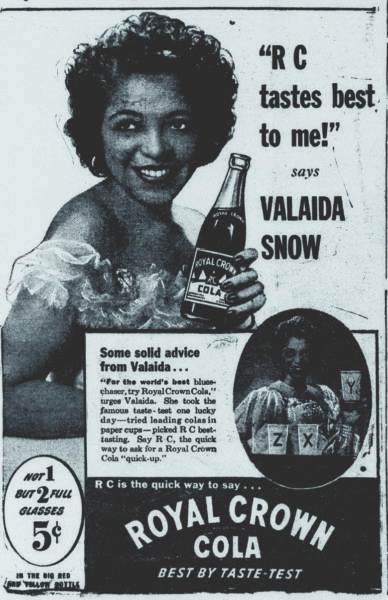

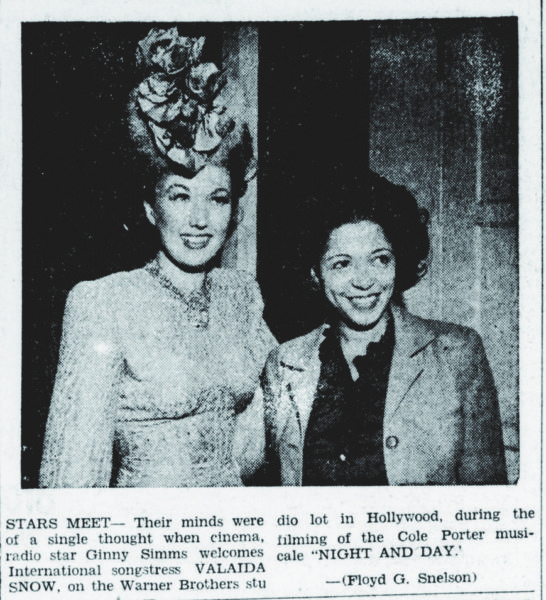
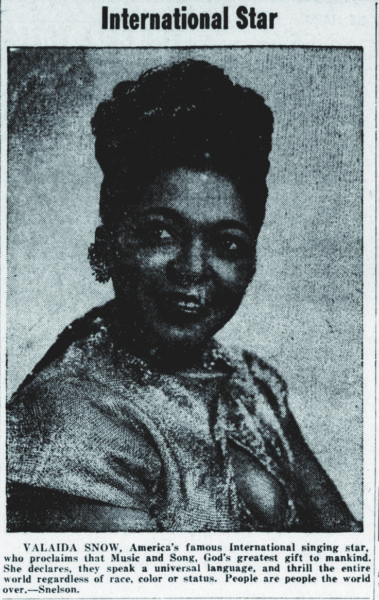
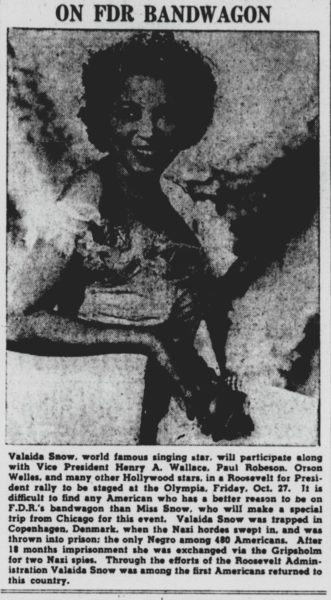
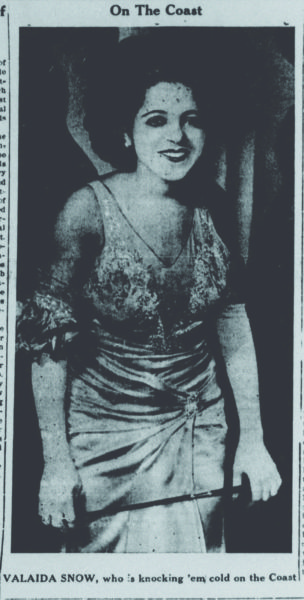
2 Comments
I’m surprised at this analysis. It doesn’t take into account the racial climate of the time or the full impact speaking out had on her career. It doesn’t discuss how her manager fled and was the first to say that she was in the concentration camp. Some of the facts in this have been considered incorrect for over a decade by the time you wrote this, and we know from studies of Holocaust victims and survivors and studies on memory that human memory can change and be incorrect at times, not to mention that people in the public eye who are abuse survivors often change their story to be listened to. Also, from a Holocaust historian, the idea that the Holocaust is only the pipeline from persecution to ghetto to death/concentration camp is reductive. It stems from the need to legitimize this horrible time that we no longer need to cling to and that other organizations that support the survivors and their descendants are actively changing (see USHMM and the rise of living memorial museums). I noted too that Clarence Lusane’s book on Black Holocaust victims is not mentioned — highly recommend you read that — and no sources from Holocaust related academia or media. Perhaps there is a chance to revisit this in the future with additional sources because the discussion of how Valaida spoke about her story and how it was received is an intriguing one.
Thank you for your thoughtful comments and the added resources! I tried to cast the net wide when looking for information on this in the hopes of finding complete and even conflicting information. At the time, I did not find materials that discredited the story I had found.